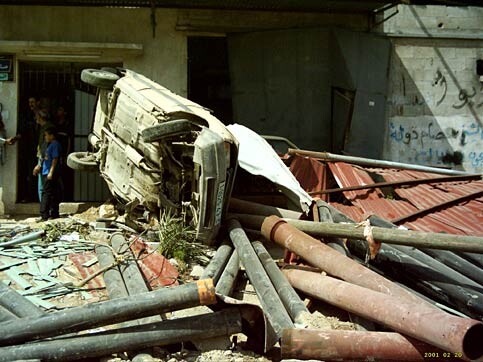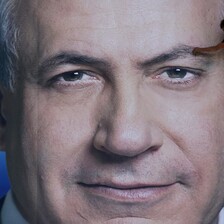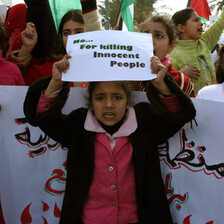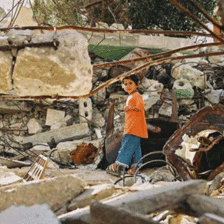
Turned over car in Zaytoun.
Our taxi wove through the narrow streets of Gaza, our driver giving us a brief tour of the horrors. We saw the house of Sheikh Yassin and the point where he was executed. Demolished Mosques, homes and businesses point the direction to the Zaytoun neighbourhood in south central Gaza City.
The past few nights have been sleepless. The Israeli forces have attacked from land, sea and air. My home, close to the sea, echoed and shook with the pounding of the shelling on the nearby Beach Camp. Further into the centre of Gaza the people of Zaytoun (which means ‘olive’) have been imprisoned in the scene of some of the most intense fighting since the Intifada began.
As our taxi driver pulls up on the outskirts of Zaytoun we have a sense of wanton destruction. The road is rubble, people clambering over it. There are thousands swarming in and out of the crevices and craters - all that remains of this neighbourhood. Around us the flags of Fatah, Hamas and Islamic Jihad are proudly displayed an indication of a people who won’t be put down, despite the destruction.
We begin to follow the ants, trying on one hand to feel that we have a purpose here. As human rights workers we are here to observe, to listen, to record: to recount. Inside me though the rotting feeling of voyeurism is settling. What right have I to be here in this grave yard?
The former road leads us past scenes of unfathomable destruction. It is impossible to imagine the sheer force of the violence which caused this. Our conversation dries up as we snake further into the centre of Zaytoun. The tumblings of trucks and burnt out cars, trees have been felled. One, then two, then three and four citrus fields come into our view. Not a single tree remained standing. Squashed unripe fruit is scattered across the hills of dust and stone.
The sun bakes us as we clamber through the former homes of people. Two Palestinian police men walk business to business, house to house. Their task is to account for the destruction and loss in each property. It is a mammoth task. The buildings are blown up using explosive devices underneath so that they collapse. The dust from the destruction covers us. I constantly wipe my camera lens clean to get a clear shot of another collapsed home, another buried car.

Demolished shop front in Zaytoun.
The Israeli bulldozers are gone - now it is the turn of the Palestinian National Authority. Their bulldozers desperately try to reshape the landscape and give it meaning once again. The telecommunications company and electricity company are try to restore a semblance of modernity to this now medieval dumping ground. Trucks resembling mini-oil tankers distribute free water to the local residents.
A crowd rushes, piling on top of itself, we turn and look. Children run to the scene. We follow the first rule of crowds in Gaza - walk the opposite direction. A huge number of civilian casualties and fatalities result from crowds rushing to look at unexploded ordinance. We hear one man shout that they have found an eye. It is not clear if it is from a Human or from one of the many donkeys whose corpses lay, only hours before, steaming in the morning sun.
The Israelis pulled out at about 0130 last night. Everybody in Gaza City knows this because that is the time they fell asleep, when the noise stopped. The IDF were looking for the body parts of their soldiers. Haaretz, the main Israeli English-language newspaper, editorialised this morning about this ‘strange fetish [for retrieving body parts]that overshadows common sense as well as simple security concerns’.
Last night on the news the mother of one of the dead soldiers cried as she expressed her desire that no more people die so that “no more mothers experience what I have experienced” in order to retrieve the body parts of her son.
Some sort of deal was concluded with the Egyptians acting as mediators. The nature of the deal is still unclear. However there is some speculation that it may include the return of Palestinian body parts. There are still 37 individual cases of body parts held by the Israelis from the first Intifada alone and numerous others from this Intifada.
Experienced Human Rights workers in my company express their shock as we survey the destruction. This, they say, is some of the worst destruction of an area since the Intifada began, worse then Rafah, comparable perhaps with Jenin. Fortunately, if that is the appropriate word, the Palestinian death toll stands at only 13 and officially 6 Israelis. It is possible, indeed likely, that other Israeli soldiers died in the operation to retrieve the body parts of the six, but we have not been told about it.
We turn to clamber back towards our taxi. Our faces are sullen, unable to consume the extent of the horror surrounding us. The dust continues to blow in our faces, the sun still bakes the people in Gaza City. On our return journey, down the streets littered with the debris of what once was a life, we are silent. My capacity for language is lost, these little labels are too small to convey reality. We look at the faces of others passing us, coming in to examine the scene, we listen to their words. I know soon they will be silent too.
Eoin Murray is an Irish Human Rights worker, based in Gaza City. He is researching on the position of Human Rights Defenders in the OPTs for Front Line, the International Foundation for the protection of Human Rights Defenders (www.frontlinedefenders.org) and he has also been published on www.opendemocracy.net.



